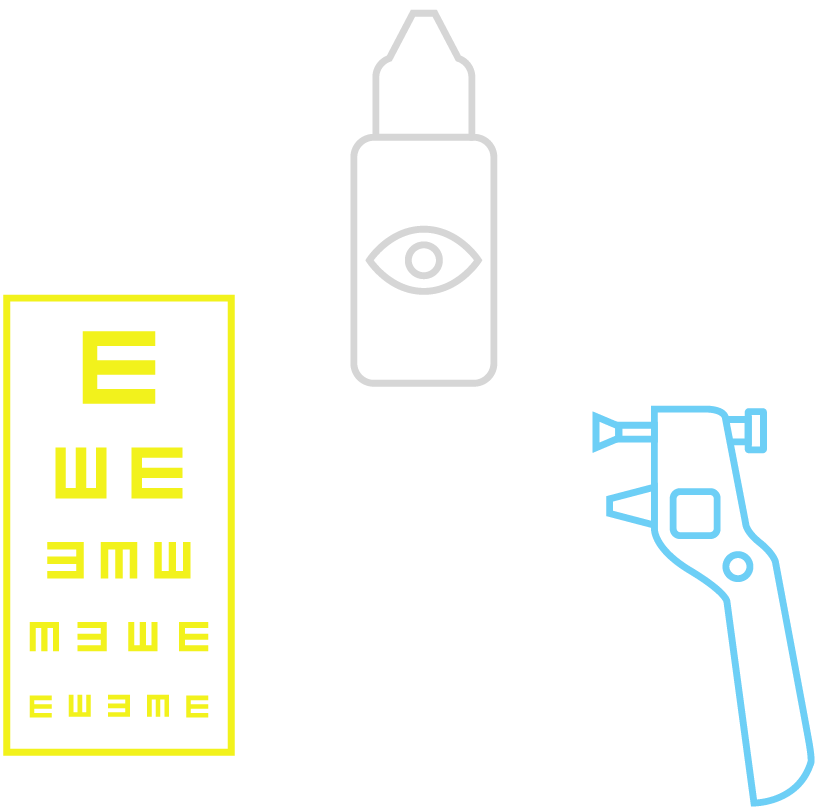



All You Need to Know about Diabetic Macular Edema (DME)
Are you or your loved one at risk of Diabetic Macular Edema (DME)? Learn all about DME, including what the condition is, symptoms, risk factors, how it’s diagnosed, as well as treatment options.
What is Diabetic Macular Edema (DME)?
Diabetic Macular Edema (DME) is a severe eye condition that can affect individuals with diabetes. DME involves the build-up of excess fluid in the macular region of the retina that can cause significant damage to vision, and in severe cases, result in blindness. ⁽ ¹ ⁾ ⁽ ² ⁾
What causes Diabetic Macular Edema (DME)?
High blood sugar levels can result in weakening of the blood vessels in the eyes, causing them to bleed and leak fluids in the retina, a condition referred to as diabetic retinopathy. The build-up of fluids causes swelling (known as edema) in an area of the retina called the macula. This resulting swelling around the macula is known as diabetic macular edema. ⁽ ² ⁾ ⁽ ³ ⁾


What are the Symptoms of Diabetic Macular Edema (DME)?
Did you know that your macula is responsible for central vision, allowing you to clearly see objects directly in front of you? It plays a major role in how you perform daily activities like reading, watching TV, doing detailed craftwork, and driving. When you have DME, your ability to see objects in your central field of vision is affected.
So how do you know if you may have DME? Look out for these common signs and symptoms: ⁽ ³ ⁾ ⁽ ⁴ ⁾
Central vision loss with dark spots in vision
DME affects the central part of the retina responsible for sharp, detailed vision. Hence, people with DME may notice a dark or empty area (scotoma) in the centre of their vision, while their side or peripheral vision (vision at the outer field) remains intact.


Colours appear washed out or less vibrant
DME may affect the perception of colours making them appear less vivid or washed out. This is because of the damage to the cones (colour perceiving cells in the centre of the retina) in the retina caused by the damage to the macula. ⁽ ⁵ ⁾


Blurred or distorted vision
As DME affects the macula, the central portion of the retina, it can cause central vision to be blurred or distorted.


Straight lines appearing wavy or distorted
This occurs when the macula, the central part of the retina responsible for detailed and central vision, is affected by the swelling and fluid accumulation caused by DME.


Who should I contact if I notice my vision getting worse?
If you or your family members experience any of these symptoms or sudden changes in vision, do consult an eye care professional as soon as possible. Early diagnosis and treatment can help slow the progression of DME and potentially preserve your vision.
Who is at Risk of Diabetic Macular Edema (DME)?
Globally, DME affects some 21 million people. ⁽ ⁶ ⁾ It is the leading cause of vision loss in people with diabetes.
Here are some key figures: ⁽ ⁷ ⁾
- 387 million persons worldwide have diabetes mellitus, this is expected to increase to 592 million by 2035
- 1 in 3 persons with diabetes mellitus have diabetic retinopathy (an eye condition caused by damage to blood vessels in the retina due to high blood sugar levels)
Persons with the following may face a higher risk of DME: ⁽ ² ⁾ ⁽ ³ ⁾
- High blood sugar levels
- High blood pressure
- High cholesterol levels
- Chronic kidney disease
- Pregnancy
The longer you have lived with diabetes, the greater your risk of getting DME. Consult a healthcare professional as soon as possible if you think you are at higher risk for this diabetic eye condition.




Why should we be concerned about Diabetic Macular Edema in Asia?
In Singapore, 1 in 12 people between 18 and 69 years old have diabetes — this means that more than 300,000 people are affected by it. ⁽ ⁸ ⁾
As our population grows older, coupled with rising obesity, the number of people with diabetes is expected to keep going up. ⁽ ⁹ ⁾ This will result in an increase in the number of people affected with DME.
When to See an Eye Doctor for Diabetic Macular Edema (DME)
If you have diabetes, the Singapore Ministry of Health (MOH) guidelines recommend that you undergo screening for diabetic eye disease annually. ⁽ ⁹ ⁾ This is because diabetes can increase the risk of vision problems, that could lead to blindness if not caught and treated early. ⁽ ¹¹ ⁾
You should also contact your doctor right away if you experience any of these symptoms: ⁽ ¹⁰ ⁾
- A change in vision or sudden blurriness
- New floaters or flashes in your vision
- Double vision
- Sudden vision loss
Do adhere to your doctor’s advice on how often to have your eyes examined.



How is Diabetic Macular Edema (DME) Diagnosed?
To diagnose DME, your eye doctor will first have a chat with you about your health history, in particular your diabetic health history (including medication and blood sugar control). Your doctor may also check for other medical conditions such as high blood pressure, elevated cholesterol, kidney disease and thyroid disease. ⁽ ¹ ⁾
They will then perform an eye examination, which may include the following tests: ⁽ ² ⁾ ⁽ ³ ⁾
- Visual acuity test: An eye chart is used to measure how clearly you can see at different distances.
- Dilated eye exam: Eye drops are used to dilate (widen) your pupils, enabling your doctor to examine the back of your eyes more clearly.






One or more of these tests may be carried out to determine a diagnosis of DME: ⁽ ² ⁾ ⁽ ³ ⁾
- Optical Coherence Tomography (OCT): This is a common imaging test to allow your ophthalmologist to see detailed cross sections of your retina. An OCT can detect the 3 basic structural changes of DME: retinal swelling, edema, and serous retinal detachment.
- Central grid (Amsler grid) test: You’ll look at an Amsler grid to check for issues with your central vision. If you have DME, you might notice curved, distorted, or missing lines/blocks in the grid.
- Fluorescein angiogram: A fluorescent dye is injected into your arm and allowed to circulate in your bloodstream. It is used to identify leaking blood vessels in your eyes or other changes to your retina.
Not all patients will undergo the same tests, your doctor will decide which tests to include as part of your eye examination.
Treatment Options for Diabetic Eye Diseases including Diabetic Macular Edema (DME)
Once you’ve been diagnosed with a diabetic eye disease such as Diabetic Macular Edema (DME), your doctor will recommend the most suitable treatment option for you according to your condition. Here are some common treatment options. ⁽ ¹ ⁾ ⁽ ² ⁾ ⁽ ³ ⁾
Intravitreal Anti-VEGF Therapy
- The treatment typically involves injecting the anti-VEGF medication directly into the affected eye or eyes.
- Commonly used anti-VEGF drugs approved by HSA Singapore include aflibercept, ranibizumab and faricimab. Faricimab is a new drug that works by blocking both VEGF and Angiopoietin-2 (Ang-2) to prevent leakage and swelling in the eye. ⁽ ¹² ⁾ (Ang-2 is another protein involved in blood vessel formation).
Laser Surgery for DME
A treatment option that aims to seal off the leaking blood vessels that cause vision problems in DME. This treatment is only recommended for very specific patients depending on their condition. ⁽ ¹³ ⁾
As DME is a diabetes-related disease, your doctor may also recommend the following strategies to manage and control your diabetes, such as:
- Diet modification
- Exercise
- Quitting smoking (for smokers)
- Close monitoring of blood glucose levels
Always adhere to your doctor’s advice on which treatment options work best for you.
References:
- [1] American Academy of Ophthalmology. EyeWiki. Diabetic Macular Edema. Available at: https://eyewiki.aao.org/Diabetic_Macular_Edema. Accessed on 19 April 2023.
- [2] For Patients by Roche. Diabetic Macular Edema. Available at: https://forpatients.roche.com/en/trials/eye-disorder/dme.html. Accessed on 19 April 2023.
- [3] Musat O, et al. Diabetic macular edema. Rom J Ophthalmol 2015;59(3):133-136.
- [4] WebMD – Diabetic Macular Edema. Available at: www.webmd.com/diabetes/diabetic-macular-edema#091e9c5e80fb6a53-1-1. Accessed on 19 April 2023.
- [5] Color Perception in patients with Diabetic Macular Edema. Available at: https://iovs.arvojournals.org/article.aspx?articleid=2780917. Accessed on 27 April 2023.
- [6] Yau JWY, et al. Global prevalence and major risk factors of diabetic retinopathy. Diabetes Care 2012;35:556-64.
- [7] AAO. ONE Network. Diabetic Retinopathy – Asia. Available at: https://www.aao.org/education/topic-detail/diabetic-retinopathy-asia#ClassificationofDiabeticMacularEdema. Accessed on 20 April 2023.
- [8] Chhablani J, et al. Diabetic macular edema management in Asian population: Expert panel consensus guidelines. Asia Pac J Ophthalmol (Phila) 2020;9:426-434.
- [9] SingHealth. Updates in detection and treatment of diabetic retinopathy in Singapore. Available at: https://www.singhealth.com.sg/news/medical-news-singhealth/updates-in-detection-and-treatment-of-diabetic-retinopathy. Accessed on 20 April 2023.
- [10] American Diabetes Association. Focus on Diabetes. Available at: https://diabetes.org/sites/default/files/2022-04/FOD-Optometrist-v-Ophthalmologist.pdf. Accessed on 20 April 2023.
- [11] American Academy of Ophthalmology – 20 reasons to see an ophthalmologist. Available at: https://www.aao.org/eye-health/tips-prevention/why-ophthalmologist-eye-exam-2020-vision. Accessed on 10 April 2023.
- [12] Vabysmo.com. How Vabysmo works. Available at: https://www.vabysmo.com/wamd/how-vabysmo-works.html. Accessed on 10 April 2023.
- [13] Laser Treatment for Diabetic Macular Edema in the 21st Century. Available at: https://www.ncbi.nlm.nih.gov/pmc/articles/PMC4051253/. Accessed on 27 April 2023.